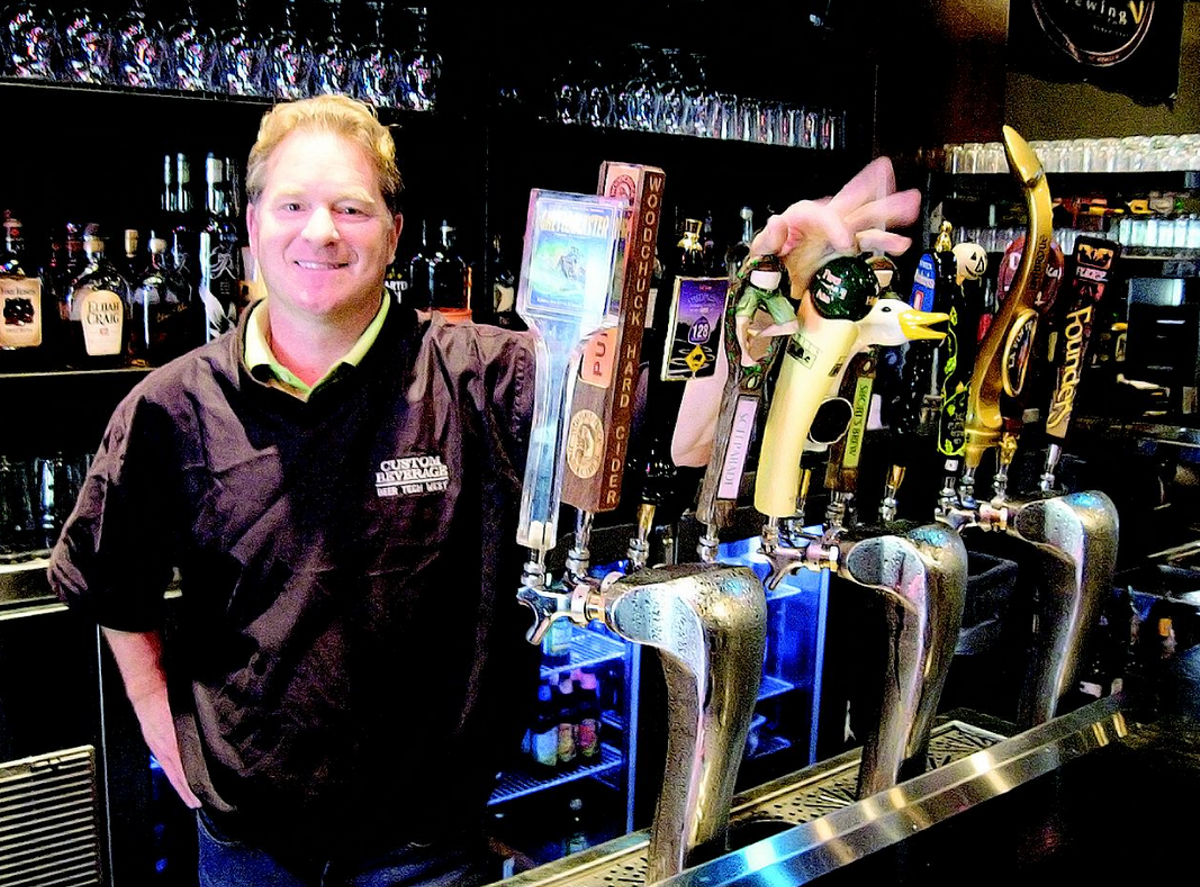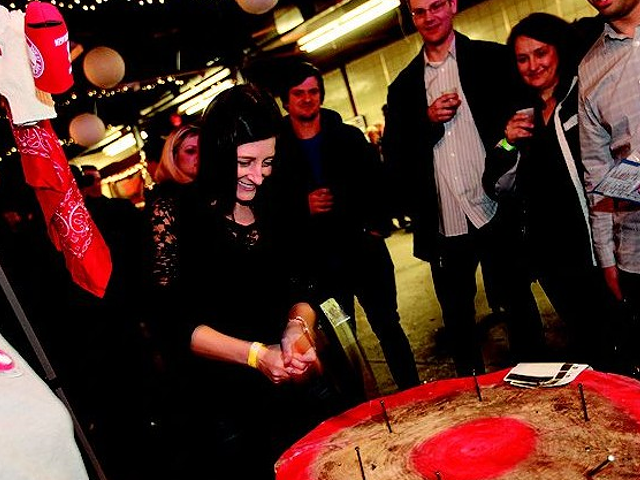It's a Wednesday afternoon, and Bob Chapman meets us at One-Eyed Betty’s before it opens. Within hours, the joint will be full of after-work revelers seeking the very best in Michigan beer and stick-to-your-ribs fare, but it’s still quiet, almost like a cathedral for the craft brew faithful before Mass. It’s a fitting setting to talk with Chapman, the sales and service guy at Ferndale’s Custom Beverage Inc. You see, Chapman is a plumber of beer. It’s his business to ensure that the kegs get through the lines and deliver cold, pure, quality beer to the tap systems in bars all over metro Detroit. In fact, he’s so busy that it’s something of a challenge to sit down with him for even a half-hour. He’s really that busy. At the Center of a Boom
When you think about all the restaurants and bars that have expanded their local beer offerings over the last decade, it all adds up to quite a lot of work for guys like Chapman. Bars that used to have a half-dozen taps at most now have dozens of handles, as customers demand more choices than simply full-bodied or light. And sophisticated systems that have high-tech gimmicks are more common than ever.
He and his wife bought the business about 10 years ago, just as the craft beer movement in Michigan was starting to take off. It hasn’t been all roses, though: Chapman says the downturn of 2007 hit bars hard. “We were losing 16 bars a week from that,” he says, mostly on the east side and in Macomb County, where the business hasn’t really recovered. Luckily, with Michganders’ newfound love of their state’s beer, the business has been growing in what he calls “trendier” areas, where a $5 or even $10 pint of Michigan beer is an affordable luxury.
Chapman reels off the list of jobs past and present, saying, “We did Rosie O’Grady’s. We did Diablo’s — and that was a nice setup. We did one better upstairs at the Red Fox; we also did Onyx in Royal Oak. We did M-Brew. We did Tequila Blue, 526 Main, Lockhart’s, and we’re redoing Woody’s — the second floor and their deck. Steel House is going up at 26 and Van Dyke; Peterlins at 9 and Farmington — quite a bit of them.”
And, of course, Chapman’s most high-profile clients would be in downtown Detroit: Comerica Park and Ford Field. “It’s interesting when you see places like Comerica and Ford Field going to Michigan crafts and going to craft beers,” he tells us. “You used to always see the standard Bud and the Miller truck showing up. Now, you got Rave showing up with all their fancy craft beers and delivering to the stadiums, which has got to be huge for those small brewers and all those local guys.”
Things are definitely changing in his line of work, and he admits he had his doubts at first. He says, “Penny Black was a big one that we did a lot of work with, and they were probably the first ones that I saw in this area selling beer in a 10-ounce glass for $15. That to me was a new strategy. I understood what they were doing and I appreciated it, but I was skeptical about whether or not that was going to succeed, and obviously they have. We started with 18 taps there and we made a custom tower for them. We took the custom tower outside to the patio and we added about ten more beers, so I think they have 28 total custom beers. Like I said, some of them are very expensive. It’s like buying a glass of booze.”
He credits the owners of beer-centric businesses with building enthusiasm for Michigan’s great suds. One-Eyed Betty’s owner, Beth Hussey, is a good example, since she took Michigan beer, repackaged it as something for young folks, and gave it a side of bacon for good measure. Hussey has, in fact, just arrived for the day and Chapman points her out. He says, “Beth studied over in Grand Rapids for a few years and came back here, so in my eyes, Beth has really opened people’s eyes to this concept and really brought this concept here Beth brought it back here and it took off like crazy here.”
The Technology of Taps
Marching in line with the sophisticated craft beer boom, today’s tap systems are much grander than your grandfather’s Bud handle. While many of them are still powered by compressed pure CO2, Chapman says nitrogen is making inroads. Chapman says, “Over time, they’ve figured out that nitrogen mixed with CO2 actually doesn’t get absorbed into the beer like straight CO2. Straight CO2 will actually get absorbed into the last part of the beer, make it foamy, and when you drink it you get that kind of full feeling. Nitrogen doesn’t get trapped into the beer like CO2 does, and it keeps the beer from getting overcarbonated.”
What’s more, you can purchase nitrogen by the tank, or even get nitrogen generators, which actually sifts out the nitrogen that makes up more than three-quarters of the atmosphere. Then it goes into a mixer that allocates a percentage of nitrogen best suited to the tap, depending on whether it pours a stout, a blend, or an ale. As Chapman tells it, “The darker, heavier brews are the ones that have the more nitrogen in them where you see the cascading effect when you pour it.” It’s a fancy setup to be sure, but it does pay, as the nitrogen mix aids in tapping that last inch or two at the bottom of the keg.
At the polar opposite of the technological spectrum are beer engines, which Chapman also can arrange. He installed the one at the Berkley Front, which uses the latest in 19th century pump technology to raise cellar-temperature beer from the basement.
When it comes to setting up taps with lots of handles, Custom Beverage has handled huge installations and ambitious expansions. “We did the taps for Rub, the barbecue place in downtown Detroit. They started out with, like, 10 or 20 taps. I think that we’re up to 72 now."
And with all that variety, some design tweaks need to be worked into the plan. Chapman tells us, “Beers all have different viscosities, so a lot of your light beers are the same, a lot of your medium beers are the same, but when you get to the heavier beers they have their own gauge. So yes, they do have to be adjusted and tempered a little bit differently.”
That often means ensuring the beer is coming through at the right pressure, and on long runs it can involve “restrictor lines,” which step down the pressure much the same way a transformer steps down electrical voltage. “If you’re sending beer a long way and it’s flying down a tube,” Chapman says, “you gotta slow it down before it hits that tap, so it doesn’t come flying out a tap and just spray all over the place.” For really long runs, the food-grade tubes are put inside special cladding designed to keep the beer cool. Chapman mentions the longest tube ever installed on his watch, a 700-foot line at Ford Field. The beer in that tube not only has to stay fresh overnight, but for as long as a week or two. That involves a sleeve for the line that keeps the beer as cold as if it were back in the keg, involving a vascular system of sorts to ensure it stays ice-cold.
Chapman mentions a host of other gizmos, such as pulsating pumps that clean out beer lines, towers designed to get so cold they cake with frost, and even “flash chillers” that send glycol through a solid aluminum block that also houses a stainless steel tube through which beer runs, giving it that last chill to ensure your beer is so cold your teeth hurt.
Pride and Fun
Chapman sounds like a guy who enjoys his business. He’s seen a lot of change over the last 10 years, most of it good. And it’s all thanks to the state’s craft beer movement. The demand is such that it feeds back into local businesses such as his. He says, “The guys that run the food and beverage side at Comerica said the same thing. Their philosophy is: ‘There are so many good beers made right here in Michigan that there’s really no reason to reach outside of that.’”
Walking back out to his truck, we pass some of the beverage suppliers crowding around Hussey to make their deals. They’re wearing T-shirts and sneakers, one wearing a long beard. It brings a smile to Chapman’s face.
He tells us, “Ten years ago, those those beverage guys would have been wearing khakis and dress shirts. You see how things change? It's just ... it's just more fun." — mt






